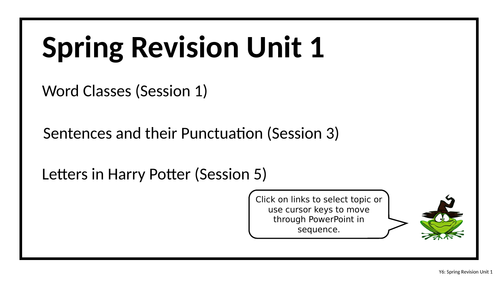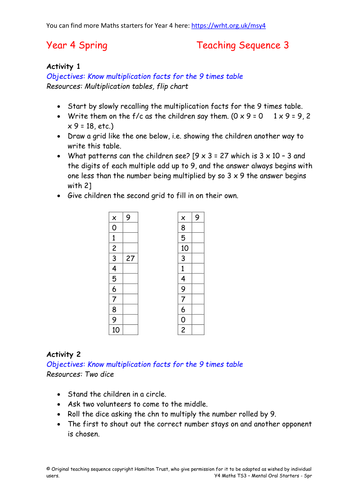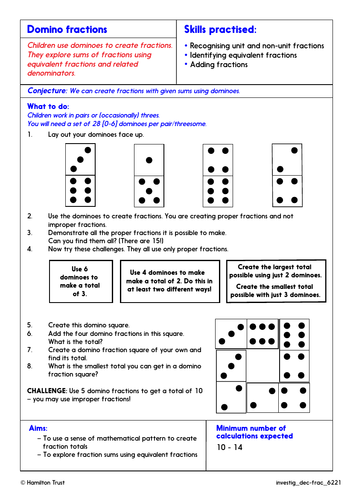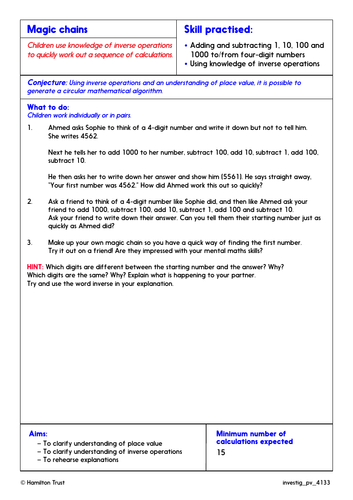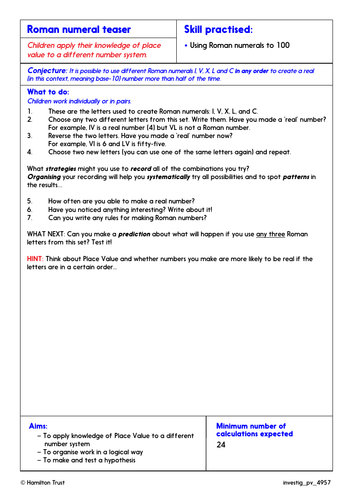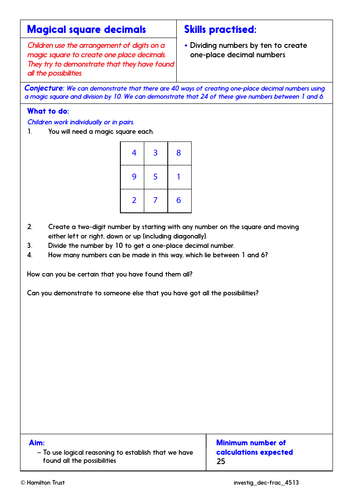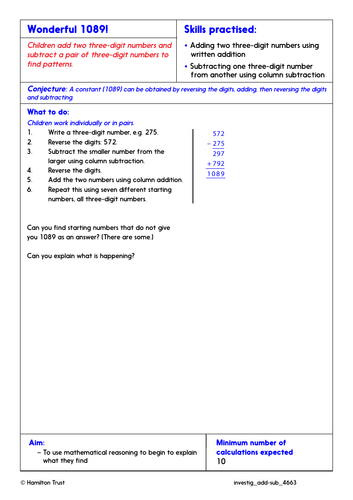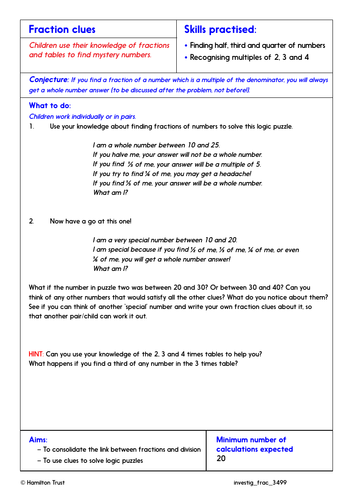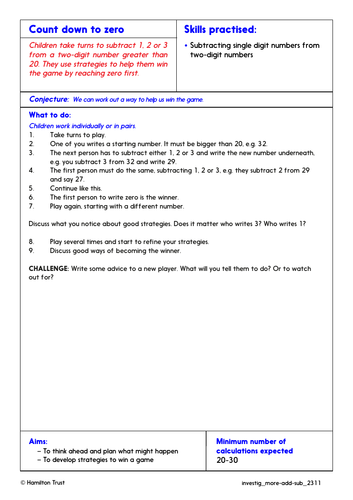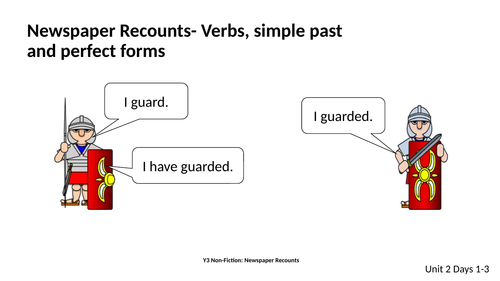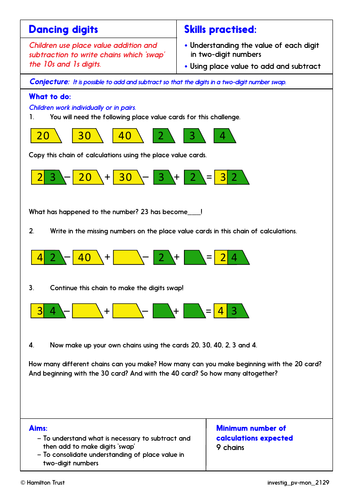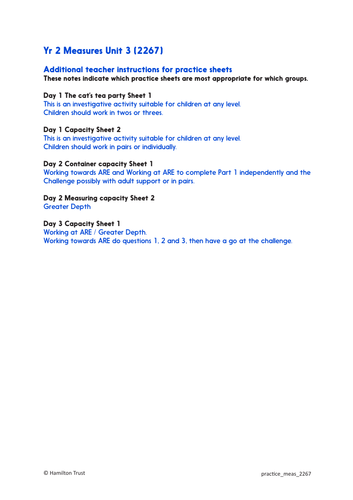
3k+Uploads
10008k+Views
11615k+Downloads

Mental Oral Starters - Year 1
Mental and oral starters for Year 1 Autumn Teaching Sequence 7.
To count and show quantities from 1 to 20 using the multiples of 5 as landmarks. To locate numbers from 1 to 20 on a beaded number line. To begin to recognise the place value structure of the ‘teen’ numbers. To begin to understand the place value structure of the ‘teen’ numbers. To begin to learn to count on from 10 in ones in the context of money. To use 1p, 2p and 5p coins to work out how much.
Find additional lesson plans and resources at www.hamilton-trust.org.uk.

Magnetic Attraction and Repulsion
Following session 7, children look at which types of material are attracted by magnets and which are not. Using an experimental approach, they also investigate the two magnetic poles on a magnet and what happens when like is placed against like, etc.
Suitable for years 3 and 4.

Mental Oral Starters - Year 4
Mental and oral starters for Year 4 Spring Teaching Sequence 3.
Know multiplication facts for the 9 times table. Revise multiplication facts for 2, 3, 4, 5, 9 and 10 times tables, and learn corresponding division facts. Recognise multiples of 2, 3, 4, 5, 9 and 10, up to the tenth multiple. Learn the 9 times table and begin to learn related division facts.
Find additional lesson plans and resources at www.hamilton-trust.org.uk.

Write dialogue using correct punctuation and a variety of reporting clauses - Year 4 SPAG
Writing and Punctuating Dialogue PowerPoint
Teach children how to write dialogue, adding the reporting clause at the start, in the middle or at the end of the speech. Rehearse end of sentence punctuation.
SPAG resources that cover the following grammar objectives:
– Use and punctuate direct speech.
Included in this unit:
Up to 3 days of teaching.
Presentation that can be used on a variety of interactive whiteboards.
Group activity resources.
This SPAG Unit is part of a larger block on Reports - Narratives of Liberation.
Find additional teaching on Hamilton’s Year 4 English Block about Reports - Narratives of Liberation.
Bundle

Year 3 Fractions - Problem-Solving Investigations
These in-depth maths investigations are open-ended problem solving activities for Year 3 children.
In-depth Investigation: Fraction Clues
Children use their knowledge of fractions and tables to find mystery numbers.
In-depth Investigation: Fraction Bets
Children look at fractions and make a hypothesis of which ones are closest. They then test this out by placing fractions on a line.
In-depth Investigation: Greedy Guzzler
Children explore which is the greater fraction of a set amount. They also fold strips to look at the fractions.
These investigations will develop maths meta-skills, support open-ended questioning and logical reasoning, and enable children to learn to think mathematically and articulate mathematical ideas.
These problem-solving investigations come from our Year 3 Maths Blocks. Each Hamilton maths block contains a complete set of planning and resources to teach a term’s worth of objectives for one of the National Curriculum for England’s maths areas.

Problem-Solving Investigation: Draw, translate, reflect polygons. (Year 6 Shape)
Year 6 Shape: Draw polygons in all quadrants; translate and reflect these.
This in-depth Maths Investigation will develop maths meta-skills, and enable children to learn to think mathematically and articulate mathematical ideas.
In-depth Investigation: Cycling Co-ordinates
Children use a sequence of co-ordinates to create quadrilaterals.
This problem-solving investigation is part of our Year 6 Shape block. Each Hamilton maths block contains a complete set of planning and resources to teach a terms worth of objectives for one of the National Curriculum for England’s maths areas.

Problem-Solving Investigation: Equivalent fractions: add and subtract (Year 6 Decimals & Fractions)
Year 6 Decimals and Fractions: Equivalent fractions: compare, add, subtract.
This in-depth Maths Investigation will develop maths meta-skills, and enable children to learn to think mathematically and articulate mathematical ideas.
In-depth Investigation: Domino Fractions
Children use dominoes to create fractions. They explore sums of fractions using equivalent fractions and related denominators.
This problem-solving investigation is part of our Year 6 Decimals and Fractions block. Each Hamilton maths block contains a complete set of planning and resources to teach a terms worth of objectives for one of the National Curriculum for England’s maths areas.

Problem-Solving Investigation: Column subtraction, choose strategies. (Y5 Addition & Subtraction)
Year 5 Addition and Subtraction: Column subtraction, and choosing a method.
This in-depth Maths Investigation will develop maths meta-skills, and enable children to learn to think mathematically and articulate mathematical ideas.
In-depth Investigation: Persistent Answers
Children subtract numbers with consecutive digits from numbers with identical digits and record the different possible answers.
This problem-solving investigation is part of our Year 5 Addition and Subtraction block. Each Hamilton maths block contains a complete set of planning and resources to teach a terms worth of objectives for one of the National Curriculum for England’s maths areas.

Problem-Solving Investigation: Place value additions: 4-digit numbers (Year 4 Place Value)
Year 4 Place Value: Add/subtract 1s, 10s, 100s and 1000s to/from 4-digit numbers.
This in-depth Maths Investigation will develop maths meta-skills, and enable children to learn to think mathematically and articulate mathematical ideas.
In-depth Investigation: Magic Chains
Children use their knowledge of inverse operations to quickly work out a sequence of calculations.
This problem-solving investigation is part of our Year 4 Place Value block. Each Hamilton maths block contains a complete set of planning and resources to teach a terms worth of objectives for one of the National Curriculum for England’s maths areas.

Count in steps of 25/1000; Roman numerals - Problem-Solving Investigation - Year 4
This in-depth maths investigation is an open-ended problem solving activity for Year 4 children. It can be used to support teaching towards the objectives: Count in steps of 25/1000; Roman numerals.
In-depth Investigation: Roman Numeral Teaser
Children apply their knowledge of place value to a different number system.
This investigation will develop maths meta-skills, support open-ended questioning and logical reasoning, and enable children to learn to think mathematically and articulate mathematical ideas.
This problem-solving investigation is part of our [Year 4 Place Value] (https://www.hamilton-trust.org.uk/maths/year-4-maths/place-value-2/) block. Each Hamilton maths block contains a complete set of planning and resources to teach a term’s worth of objectives for one of the National Curriculum for England’s maths areas.

Introduction to one place decimals - Problem-Solving Investigations - Year 4
This in-depth maths investigation is an open-ended problem solving activity for Year 4 children. It can be used to support teaching towards the objectives: Introduction to one place decimals.
In-depth Investigation: Magical Square Decimals
Children use the arrangement of digits on a magic square to create one place decimals. They try to demonstrate that they have found all the possibilities.
This investigation will develop maths meta-skills, support open-ended questioning and logical reasoning, and enable children to learn to think mathematically and articulate mathematical ideas.
This problem-solving investigation is part of our Year 4 Decimals and Fractions block. Each Hamilton maths block contains a complete set of planning and resources to teach a term’s worth of objectives for one of the National Curriculum for England’s maths areas.

Subtraction strategies; written methods - Problem-solving Investigation - Year 4
This in-depth maths investigation is an open-ended problem solving activity for Year 4 children. It can be used to support teaching towards the objectives : Subtraction: written methods and choosing strategies
In-depth Investigation: Wonderful 1089!
Children add two 3-digit numbers and subtract a pair of 3-digit numbers to find patterns. They use mathematical reasoning to begin to explain what they find.
This investigation will develop maths meta-skills, support open-ended questioning and logical reasoning, and enable children to learn to think mathematically and articulate mathematical ideas.
This problem-solving investigation is part of our Year 4 Addition and Subtraction block. Each Hamilton maths block contains a complete set of planning and resources to teach a term’s worth of objectives for one of the National Curriculum for England’s maths areas.

Develop the concept of fractions - Problem-Solving Investigation - Year 3
This in-depth maths investigation is an open-ended problem solving activity for Year 3 children. It can be used to support teaching towards the objectives: Develop the concept of fractions.
In-depth Investigation: Fraction Bets
Children look at fractions and make a hypothesis of which ones are closest. They then test this out by placing fractions on a line.
This investigation will develop maths meta-skills, support open-ended questioning and logical reasoning, and enable children to learn to think mathematically and articulate mathematical ideas.
This problem-solving investigation is part of our Year 3 Fractions block. Each Hamilton maths block contains a complete set of planning and resources to teach a term’s worth of objectives for one of the National Curriculum for England’s maths areas.

Finding 1/2, 1/4, 3/4, 1/3, 2/3 of amounts - Problem-Solving Investigation - Year 3
This in-depth maths investigation is an open-ended problem solving activity for Year 3 children. It can be used to support teaching towards the objectives: Finding 1/2, 1/4, 3/4, 1/3, 2/3 of amounts.
In-depth Investigation: Fraction Clues
Children use their knowledge of fractions and tables to find mystery numbers.
This investigation will develop maths meta-skills, support open-ended questioning and logical reasoning, and enable children to learn to think mathematically and articulate mathematical ideas.
This problem-solving investigation is part of our Year 3 Fractions block. Each Hamilton maths block contains a complete set of planning and resources to teach a term’s worth of objectives for one of the National Curriculum for England’s maths areas.

Problem-Solving Investigation: Add/subtract 11, 12, 21, 22, etc (Year 2 More Addition & Subtraction)
Year 2 More Addition and Subtraction: Add/subtract 11, 12, 21, 22, etc. to/from 2-digit numbers.
This in-depth Maths Investigation will develop maths meta-skills, and enable children to learn to think mathematically and articulate mathematical ideas.
In-depth Investigation: Count Down to Zero
Children take turns to subtract 1, 2 or 3 from a 2-digit number greater than 20. They use strategies to help them win a game by reaching zero first.
This problem-solving investigation is part of our Year 2 More Addition and Subtraction block. Each Hamilton maths block contains a complete set of planning and resources to teach a terms worth of objectives for one of the National Curriculum for England’s maths areas.

Verb tense, perfect form and role-play (Presentation & Exercises) - Year 3 SPAG
Presentation and practice exercises to teach children about verbs, noting what defines an active verb. Explain tense, and introduce present, simple past, then present perfect form.
SPAG resources that cover the following grammar objectives:
– Use the present perfect form of verbs in contrast to the past tense
(Revise simple past and present verb forms)
Included in this unit:
Up to three days of teaching
Presentation that can be used on a variety of interactive whiteboards.
Group activity resources.
This SPAG Unit is part of a larger block on Newspaper Recounts.
Find additional teaching on Hamilton’s Year 3 English Block about Newspaper Recounts.

Problem-Solving Investigation: Understanding and identifying 2-D shapes (Year 1 Shape and Data)
Year 1 Shape and Data: Understanding and identifying 2-D shapes
This in-depth Maths Investigation will develop maths meta-skills, and enable children to learn to think mathematically and articulate mathematical ideas.
In-depth Investigation: Shape Wheels
Children make a sequence of coloured shapes, changing one attribute at a time so that the sequence can end where it started, forming a circular sequence.
This problem-solving investigation is part of our Year 1 Shape and Data block. Each Hamilton maths block contains a complete set of planning and resources to teach a terms worth of objectives for one of the National Curriculum for England’s maths areas.

Problem-Solving Investigation: Place value in 2-digit numbers (Year 2 Place Value and Money)
Year 2 Place Value and Money: Place value in 2-digit numbers.
This in-depth Maths Investigation will develop maths meta-skills, and enable children to learn to think mathematically and articulate mathematical ideas.
In-depth Investigation: Dancing Digits
Children use place value addition and subtraction to write chains which ‘swap’ the 10s and 1s digits.
This problem-solving investigation is part of our Year 2 Place Value and Money block. Each Hamilton maths block contains a complete set of planning and resources to teach a terms worth of objectives for one of the National Curriculum for England’s maths areas.

Practice Worksheets: Measure capacities in half litres and litres (Year 2 Measures)
Year 2 Measures: Measure capacities in half litres and litres.
Procedural fluency Practice Worksheets to achieve maths mastery. Differentiated for children working towards Age Related Expectations (ARE), at ARE and at greater depth.
Day 1
Investigate the numbers of mugs that can be poured from a teapot of given capacity. Make paper containers, then compare and estimate their capacities.
Day 2
Sort a variety of containers under headings: more than 1 litre and less than 1 litre.
Interpret capacity data from a bar graph.
Day 3
Estimate and order container capacity relative to 1/2 a litre and 1 litre.
These procedural fluency practice sheets are part of our Year 2 Measures block. Each Hamilton maths block contains a complete set of planning and resources to teach a terms worth of objectives for one of the National Curriculum for England’s maths areas.

Practice Worksheets: Add/subtract 11, 12, 21, 22, etc (Year 2 More Addition and Subtraction)
Year 2 More Addition and Subtraction: Add/subtract 11, 12, 21, 22, etc. to/from 2-digit numbers.
Procedural fluency Practice Worksheets to achieve maths mastery. Differentiated for children working towards Age Related Expectations (ARE), at ARE and at greater depth.
Day 1
Most children create their own questions by selecting pairs of numbers to add. Some will complete a challenge involving missing numbers.
Day 2
Children are set different challenges to add 11, 12, 13, 21, 22, 23, 31, 32 or 33 to other 2-digit numbers; answers ≤110.
Day 3
Children calculate which of a set of given numbers is required to make a set of given calculations correct.
These procedural fluency practice sheets are part of our Year 2 More Addition and Subtraction block. Each Hamilton maths block contains a complete set of planning and resources to teach a terms worth of objectives for one of the National Curriculum for England’s maths areas.

